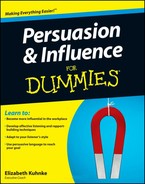Chapter 15
Ten Sure-Fire Ways to Influence Anyone
In This Chapter
![]() Venturing beyond words
Venturing beyond words
![]() Supporting your side
Supporting your side
![]() Making the most of others
Making the most of others
![]() Working together
Working together
In Henrik Ibsen’s play The Master Builder, the lead character imagines that by wishing for something, it will come true. At the end of the play, he falls to his death. I’m not suggesting that you might die by wishing to become a great influencer! Rather, I’m suggesting that becoming a skilled persuader leads to a much happier outcome than simply wishing, hoping, thinking and praying ever can.
If you’ve ever watched in awe as someone persuaded another to do something she originally disdained (or at least doubted), this chapter serves up ten secrets from successful persuaders that you can utilise in your own interactions.
Establish Trust
Try to get someone to follow your lead without first establishing trust, and watch your efforts collapse at the starting gate. If someone doesn’t trust you, why would she possibly want to follow you? Being perceived as trustworthy requires that you demonstrate your credibility.
‘Walking your talk’ is one way of building a reputation for being trustworthy and credible. Behaving in a way that reflects your beliefs and values shows you’re a person who’s true to your word. Walking your talk manifests itself in simple, everyday activities: show up on time, tell the truth and act in other people’s interests. Do these consistently, and people see you as someone whom they can trust to do what you say you’ll do. See Chapters 1 and 5 for more on trust and credibility.
Set Out Crystal-Clear Goals
The best persuaders and influencers are confident about what they want. They state their desired outcomes from the start in clear, concise and compelling terms that their listeners can understand and relate to.
Step Into the Other Person’s Shoes
Sun Tzu writes in his classic The Art of War that the person who knows both the enemy and himself need not fear the result of a hundred battles. The more you know about what matters to other people, the more ammunition you have for persuading them to accept your point of view. Gear your proposal to the other people’s needs and concerns, and watch them flock to your fold.
You can find out how to identify what motivates your listener in Chapter 2, and in Chapter 3 you gain tips for figuring out people’s attitudes and beliefs. Ask questions and focus on the answers you receive. Listen not only for the words others say but the way they say them too. Someone’s non-verbal behaviour – including body language and vocal qualities (see Chapters 13 and 14 – often reveals feelings and attitudes that are as much a part of her perspective as the words she speaks.
Find out as much as you can about what matters to your listeners and let them know that you respect them as individuals as well as respecting their points of view. The more you acknowledge their perspectives, the more willing they are to take on board your suggestions – or even join your proposed plans. Turn to Chapter 12 if you want to figure out who you’re talking to.
Behave Congruently
When the words you’re saying and the way you’re saying them match, you’re behaving congruently. Your message and delivery match, and your listener knows what you mean. If your words say one thing and the way you say them communicates something different, your listeners are likely to feel bewildered. Consider the pitch, pace and tone of your voice. People generally believe what they observe more than the words they hear, so also pay attention to your non-verbal behaviours such as your posture, movements and gestures.
If you’re uncertain and unconvincing in the way you present your case, you send out a message of doubt, uncertainty and indecision that your listeners will remember. Speak clearly, concisely and with conviction. Move like you mean it and eliminate ums, ers and ahs from your vocabulary.
Ask for More than You Expect
My son has a quote on his pinboard that says, ‘Shoot for the moon. Even if you miss you’ll land among the stars.’ Or to paraphrase former US Secretary of State Henry Kissinger, your effectiveness at the conference table depends on overstating your demands.
Asking for more than you expect to get gives you some wiggle room, some space for negotiating. For example, when you’re selling, you can always come down from your initial offer, but never expect the buyer to suggest that you ask for more. Conversely, if you’re buying something, your offer can always go up, but you’d be hard pressed to go down from your original offer. See Chapter 12 for the ins and outs of establishing useful expectations.
Respect Your Relationships
What goes around comes around. How you treat people determines how they respond to you. Treat people with respect and watch them return the favour.
Aim to identify with, understand and respond to other people’s feelings, emotions and experiences. Demonstrating empathy (see Chapter 3) goes a long way in building a positive relationship that in turn benefits you.
Build Your Case
As Henry Ford said, ‘Before anything else, getting ready is the secret to success.’ Knowing what you want, knowing your audience and knowing how to present to your audience in a way that captures their attention and sustains their interest boosts your chances of walking away a winner.
![]() Start with a strong opener that grabs your listeners’ attention and resonates with their values.
Start with a strong opener that grabs your listeners’ attention and resonates with their values.
![]() Express each point clearly in a single sentence and assert your claims as statements of fact.
Express each point clearly in a single sentence and assert your claims as statements of fact.
![]() Avoid overwhelming your listener with too much information. Try limiting yourself to three main messages, each of which needs to be compelling on its own.
Avoid overwhelming your listener with too much information. Try limiting yourself to three main messages, each of which needs to be compelling on its own.
![]() Back up your claims with appropriate supporting material that your listener can believe and accept. Make sure your claims are correct.
Back up your claims with appropriate supporting material that your listener can believe and accept. Make sure your claims are correct.
![]() Deliver your message with feeling.
Deliver your message with feeling.
![]() Conclude your case with a call to action that ties in with your opening. Make your case short, sharp and memorable.
Conclude your case with a call to action that ties in with your opening. Make your case short, sharp and memorable.
Whatever you say, make sure it’s relevant. Be creative. Include stories, analogies and vivid language to help your audience visualise and connect with what you’re saying.
Offer Your Most Captivating Reasons
People need reasons for knowing why you want them to do what you want them to do. Although ‘Because I said so’ may gain their compliance, it’s unlikely to gain their hearts and minds.
Let your audience know how your request benefits them. Appeal to their values and tie your reasons into their self-interests and then watch them jump over themselves to comply with your request. Use language that’s both accurate and exciting to get your audience visualising your recommendations. Provide your listeners with significant facts and figures if they’re into the detail. Tell them captivating stories, including metaphors and analogies if they like to look at the big picture. The more captivating the way you present your case, the more chance you stand of success.
Seek Common Ground
When people like you, they’re more likely to comply with your requests. The more you have in common with the people you want to persuade, the more likely they’ll like you. Turn to Chapter 10 to find out about the power of liking someone.
Effective persuaders seek out similarities between themselves and the people they want to influence. The more you know about your target audience and the more you establish genuine shared aims and chances for camaraderie, the more likely your chances of persuading them. Chapter 2 is filled with tips for finding out about other people.
Own Up to Your Weaknesses
To gain buy-in – to get people to commit to you and your proposals – you’ve got to gain trust. One of the most effective ways to persuade others that you’re trustworthy, honest and credible is to admit your weaknesses.
In Chapter 6 you find out how to admit to your weaknesses without damaging your credibility.

 When my sister Wendy wanted our late grandmother to do something she wasn’t convinced was in her best interests, all Wendy had to do was look her in the eye, smile and say, ‘Trust me, Memaw!’ Sure enough, Memaw would do what Wendy wanted. Memaw and Wendy liked one another, and because Wendy always told Memaw the truth and acted in her best interests, Memaw trusted her. ‘Trust me, Memaw!’ has become the rallying cry in our family whenever we want our parents or siblings to do something they’re not so sure about doing.
When my sister Wendy wanted our late grandmother to do something she wasn’t convinced was in her best interests, all Wendy had to do was look her in the eye, smile and say, ‘Trust me, Memaw!’ Sure enough, Memaw would do what Wendy wanted. Memaw and Wendy liked one another, and because Wendy always told Memaw the truth and acted in her best interests, Memaw trusted her. ‘Trust me, Memaw!’ has become the rallying cry in our family whenever we want our parents or siblings to do something they’re not so sure about doing. Revisit your goals regularly as you travel along your path to persuasion. Whether your goals are quantitative or qualitative, simple or multi-faceted, you’ll struggle to achieve them unless you know what they are. See Chapter 1 for more on clarity and Chapter 4 for advice on using compelling language.
Revisit your goals regularly as you travel along your path to persuasion. Whether your goals are quantitative or qualitative, simple or multi-faceted, you’ll struggle to achieve them unless you know what they are. See Chapter 1 for more on clarity and Chapter 4 for advice on using compelling language.